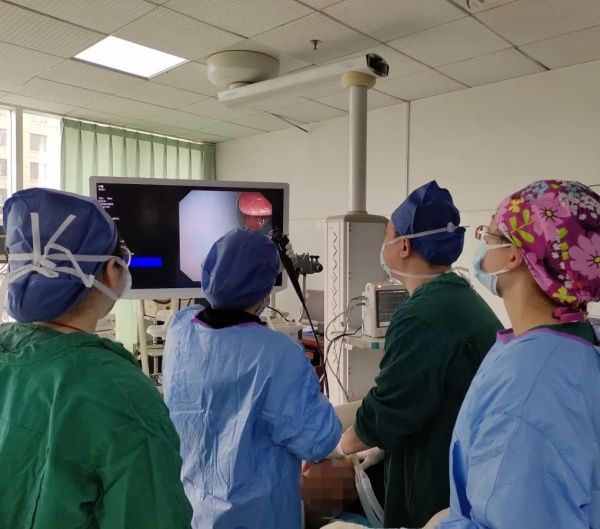It was originally just a routine physical examination. Mr. Yang, 56, found a shadow in his lungs. Although the doctor did not say that it is cancer, it is only recommended to review it regularly. But he was still very worried, that shadow was like a time bomb, and one day it would turn cancerous.
“What should I do if shadows and small nodules are found in the lungs?”
“What tests should be done?”
“Is it a tumor?”
“Is it painful? Is the injury serious?”
During the physical examination, Mr. Yang found shadows in the lungs and enlarged hilum of the lungs. He underwent bronchoscopy in a local hospital, and the intraoperative mucosal biopsy was not positive. As a result, this made Mr. Yang anxious. “I don’t know any disease, so how can I treat it?” Through a friend’s introduction, Mr. Yang came to the outpatient department of respiratory and critical care medicine of the First People’s Hospital of Jingmen City. The lymph nodes at the hilum of the lung were swollen, and the previous bronchoscopy results showed that there were no obvious new organisms in the lumen.
In this case, percutaneous lung puncture may have a high risk of bleeding, and further, surgery cannot be rashly removed without pathological findings. After some deliberation, the patient was recommended for further hospitalization.
After discussions with the members of the respiratory intervention group in the Department of Respiratory and Critical Care Medicine, Director Jin Ming finally made a final decision – to recommend Mr. Yang to undergo bronchoscopy with ultrasound needle aspiration biopsy (EBUS – TBNA). Previously, patients needed to go to provincial hospitals for further diagnosis and treatment, which cost a lot of energy and financial resources. Now this problem can also be solved in the Department of Respiratory and Critical Care Medicine of Jingmen No. 1 Hospital.
After the attending physician communicated with Mr. Yang, he was very worried and felt that the bronchoscopy was uncomfortable. What if he suffered pain and still no results? The attending physician patiently explained, “You can rest assured that this operation does not require endotracheal intubation, it is minimally invasive and safe, the operation is simpler, and the medical expenses are lower.” Yang Mr. “I didn’t expect to even need a tracheal intubation, I’m not so afraid.”
Detailed explanation of the principle:The ultrasound bronchoscope (EBUS) is a kind of device installed at the front of the bronchoscope. The device of the ultrasound probe, combined with the special suction needle, can be used for transbronchial needle aspiration (TBNA) under the guidance of real-time ultrasound to obtain histological and cytological pathological diagnosis. The electronic convex array scanning color power Doppler can help to confirm the position of the blood vessel and prevent the blood vessel from being pierced by mistake.

The principle of the device creates the advantage of its precise puncture. It can clearly show the relationship between blood vessels, lymph nodes and space-occupying lesions in the mediastinum outside the airway, completely solve the problem of “blind puncture” in traditional surgery, and improve the safety and accuracy of this technology.
Applicable people:This technique is mainly used for the lymph node metastasis stage of lung cancer, and it is also used to diagnose intrapulmonary tumors, unexplained hilar and/or mediastinal lymph node enlargement, Mediastinal tumors, etc.
After the doctor patiently explained the principle of bronchoscopy ultrasound needle aspiration biopsy and the advantages of this examination selected for Mr. Yang’s condition, he finally understood and agreed. Under the guidance of Director Jin Ming and the assistance of anesthesiologists, Deputy Director Zhou Jinling quickly found the lesion site with an endoscopic ultrasound, accurately measured the puncture angle and puncture length, skillfully avoided the blood vessels, and successfully completed an effective biopsy. The patient was safely returned to the ward after the operation.
During surgery


“I thought this bronchoscopy would be very painful, but I didn’t expect that the examination would be done after I slept, and there was no discomfort after the examination. The most important thing is that it can be done at the door. Completing these examinations saves me the pain of rushing to seek medical treatment abroad.”
Don’t panic when you find out the shadows in your lungs, find out the cause, and active treatment is the key! EBUS technology has great clinical value for the diagnosis and staging of lung cancer and individualized treatment of lung cancer. The Department of Respiratory and Critical Care Medicine of Jingmen No. 1 Medical Center can develop this technology in a mature manner, providing Jingmen citizens with high-precision technical services at their doorsteps. (Correspondent Chen Huilin)